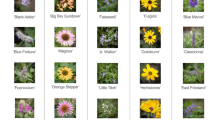Summary
The pollination biology of the 20 plant species of a treeless, pavement plain in the San Bernardino Mountains of southern California was studied throughout one flowering season.
Several patterns of pollinator activity recorded during the season underline the necessity for noting the activity of all insect pollinators whether specialized, non-specialized, regular, or occasional:
-
1)
Occasional insect visitors were a feature of the visitation to nine of the twelve entomophilous plant species and were the sole pollinators for three of these twelve species.
-
2)
The eight entomophilous plant species which had open, generalized flower morphologies received the heaviest pollinator visitation, while three of the four entomophilous species with specialized flower morphologies received little visitation.
-
3)
Most regular flower visitors, whether bees, flies, or wasps, appeared to be similar with respect to number of plant species visited regularly, purity of pollen load, length of residence and localization of activity on the site.
The question is raised as to whether such similarity of behavior as pollen vectors is a function of the low plant diversity or a feature commonly found when the pollen loads and behavior of different pollinator types are actually monitored.
Similar content being viewed by others
References
Beattie AJ (1972) The pollination ecology of Viola 2. Pollen loads of insect-visitors. Watsonia 9:13–25
Beattie AJ (1974) Floral evolution in Viola. Ann M Bot Gard 61:781–793
Bohart RM, Menke AS (1976) Sphecid wasps of the world. Univ of Calif Press, Berkeley
Cole FR (1969) The flies of western North America. Univ of Calif Press, Berkeley
Cruden RW (1972) Pollination biology of Nemophila menziesii (Hydrophyllaceae) with comments on the evolution of oligolectic bees. Evolution 26:373–389
Curran CH (1934) The families and genera of North American Diptera The Ballou Press, New York
Del Moral R, Standley LA (1979) Pollination of angiosperms in contrasting coniferous forests. Am J Bot 66:26–35
Derby JA (1979) Floristics and phytosociology of the pavement plains in the San Bernardino Mountains, California. Thesis, California State College, San Bernardino, Calif
Emmel TC, Emmel JF (1973) The butterflies of souther, California. Natural History Museum of Los Angeles County. Los Angeles
Faegri K, Van der Pijl L (1971) The principles of pollination ecology. Pergamon Press, Oxford
Free JB (1963) The flower constancy of honeybees. J. Anim. Ecol. 32:119–131
Free JB (1970) The flower constancy of bumblebees. J Anim Ecol 39:395–402
Grant V (1950) The flower constancy of bees. Bot Rev 16:379–398
Hagerup O (1950) Rain-pollination. Biol. Meddel. Kongel. Danske Vidensk 18 (5):1–19
Hagerup O (1951) Pollination in the Faroes — in spite of rain and poverty in insects. Biol Meddel Kongel Danske Vidensk 18 (15):1–48
Heinrich B (1973) The energetics of the bumblebee. Sci Amer 228:96–102
Heinrich B (1975a) Bee flowers: a hypothesis on flower variety and blooming times. Evolution 29:325–334
Heinrich B (1975b) Energetics of pollination. Ann Rev Ecol Syst 6:139–170
Heinrich B (1976a) Resource partitioning among some eusocial insects: bumblebees. Ecology 57:874–889
Heinrich B (1976b) The foraging specializations of individual bumblebees. Ecol Monogr 46:105–128
Heinrich B (1979) “Majoring” and “minoring” by, foraging bumblebees, Bombus vagans: an experimental analysis. Ecology 60:245–255
Heinrich B, Raven P (1972) Energetics and pollination ecology. Science 176:597–602
Heithaus ER (1974) The role of plant-pollinator interactions in determining community structure. Ann M Bot Gard 61:675–691
Hocking B (1968) Insect-flower associations in the high Arctic with special reference to nectar. Oikos 19:359–388
Jones CE (1978) Pollimator constancy as a pre-pollination isolating mechanism between sympatric species of Cercidium. Evolution 32: 189–198
Kevan PG (1970) Insect pollination of high arctic flowers. J Ecol 60:831–847
Linsley EG (1958) The ecology of solitary bees. Hilgardia 27:543–599
Linsley EG (1966) Pollinating insects of the Galapagos Islands. In: RI Bowman (ed), The Galapagos. Univ Calif Press. Berkeley, p 225–232
McAlpine JF (1965) Observations on anthophilous Diptera at Lake Hazen, Ellesmere Island. Can Field-Naturalist 79:247–252
Macior LW (1974) Pollination ecology of the Front Range of the Colorado Rocky Mountains. Melanderia 15:1–59
Mulligan GA (1972) Autogamy, allogamy, and pollination in some Canadian weeds. Can J Bot 50:1767–1771
Moldenke AR (1975) Niche specialization and species diversity along a California transect. Oecologia (Berl) 21:219–242
Moldenke AR (1976) California pollination ecology and vegetation types. Phytologia 34:305–361
O'Brien MH (1979) Pollination biology of a pavement plain in the San Bernardino Mountains, California. Thesis, Rancho Santa Ana Botanic Garden, Claremont, California
Pleasants JM (1977) Competition in plant-pollinator systems: an analysis of meadow communities in the Colorado Rocky Mts. Ph D Thesis Univ of Calif, Los Angeles
Pojar J (1974) Reproductive dynamics of four plant communities of southwestern British Columbia Can J Bot 52:1819–1834
Rick CM (1966) Some plant-animal relations on the Galapagos Islands. In: RI Bowman (ed), The Galapagos, Univ Calif Press. Berkeley: p 215–224
Schemske DW, Willson MF, Melampy MN, Miller LJ, Verner L, Schemske KM, Best LB, (1978) Flowering ecology of some spring woodland herbs. Ecology 59:351–366
Small E (1976) Insect pollinators of the Mer Bleue peat bog of Ottawa. Can Field-Naturalist 90:22–28
Stephen WP, Bohart GE, Torchio PF (1969) The biology and external morphology of bees. Corvallis, Agricultural Experiment Station, Oregon
Author information
Authors and Affiliations
Rights and permissions
About this article
Cite this article
O'Brien, M.H. The pollination biology of a pavement plain: pollinator visitation patterns. Oecologia 47, 213–218 (1980). https://doi.org/10.1007/BF00346823
Received:
Issue Date:
DOI: https://doi.org/10.1007/BF00346823




